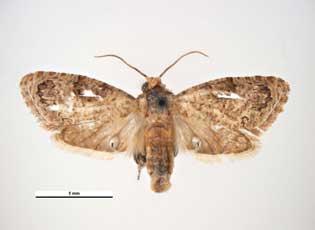Thaumatotibia leucotreta (Meyrick), formerly known as Cryptophlebia leucotreta (Gilligan et al. 2011)
False codling moth (FCM), citrus codling moth
Africa (Carpenter et al. 2007)
Not currently established; first detected outside of commercial shipments in California in 2008 (Gilligan et al. 2011)
Frequently intercepted on plant material arriving from Africa (Carpenter et al. 2007)
Pest of many fruit trees and crops, including citrus, cotton, and maize (Carpenter et al. 2007)
Not currently established

False codling moth, adult male dorsal
Photo by Pest and Diseases Library
Distribution / Maps / Survey Status
All Resources
Selected Resources
The section below contains highly relevant resources for this species, organized by source.
Partnership
Federal Government
International Government
State and Local Government
Carpenter, J., S. Bloem, and H. Hofmeyr. 2007. Area-wide control tactics for the false codling moth Thaumatotibia leucotreta in South Africa: a potential invasive species. In: M.J.B. Vreysen, A.S. Robinson, and J. Hendrichs, eds. Area-Wide Control of Insect Pests. Springer, Dordrecht.
Gilligan, T.M., M.E. Epstein, and K.M. Hoffman. 2011. Discovery of false codling moth, Thaumatotibia leucotreta (Meyrick), in California (Lepidoptera: Tortricidae). Proceedings of the Entomological Society of Washington 113(4):426-435.
